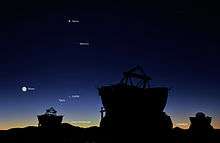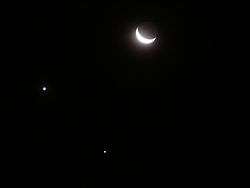Conjunction (astronomy)

In astronomy, a conjunction occurs when two astronomical objects or spacecraft have either the same right ascension or the same ecliptic longitude, usually as observed from Earth.[1][2]
The astronomical symbol for conjunction is ☌ (in Unicode U+260C) and handwritten ![]() . The conjunction symbol is not used in modern astronomy. It continues to be used in astrology.
. The conjunction symbol is not used in modern astronomy. It continues to be used in astrology.
When two objects always appear close to the ecliptic – such as two planets, the Moon and a planet, or the Sun and a planet – this fact implies an apparent close approach between the objects as seen on the sky. A related word, appulse, is the minimum apparent separation on the sky of two astronomical objects.[3]
Conjunctions involve either two objects in the Solar System or one object in the Solar System and a more distant object, such as a star. A conjunction is an apparent phenomenon caused by the observer's perspective: the two objects involved are not actually close to one another in space. Conjunctions between two bright objects close to the ecliptic, such as two bright planets, can be seen with the naked eye.
Passing close

More generally, in the particular case of two planets, it means that they merely have the same right ascension (and hence the same hour angle). This is called conjunction in right ascension. However, there is also the term conjunction in ecliptic longitude. At such conjunction both objects have the same ecliptic longitude. Conjunction in right ascension and conjunction in ecliptic longitude do not normally take place at the same time, but in most cases nearly at the same time. However, at triple conjunctions, it is possible that a conjunction only in right ascension (or ecliptic length) occur. At the time of conjunction – it does not matter if in right ascension or in ecliptic longitude – the involved planets are close together upon the celestial sphere. In the vast majority of such cases, one of the planets will appear to pass north or south of the other.
Passing closer
However, if two celestial bodies attain the same declination at the time of a conjunction in right ascension (or the same ecliptic latitude at a conjunction in ecliptic longitude), the one that is closer to the Earth will pass in front of the other. In such a case, a syzygy takes place. If one object moves into the shadow of another, the event is an eclipse. For example, if the Moon passes into the shadow of Earth and disappears from view, this event is called a lunar eclipse. If the visible disk of the nearer object is considerably smaller than that of the farther object, the event is called a transit. When Mercury passes in front of the Sun, it is a transit of Mercury, and when Venus passes in front of the Sun, it is a transit of Venus. When the nearer object appears larger than the farther one, it will completely obscure its smaller companion; this is called an occultation. An example of an occultation is when the Moon passes between Earth and the Sun, causing the Sun to disappear either entirely or partially. This phenomenon is commonly known as a solar eclipse. Occultations in which the larger body is neither the Sun nor the Moon are very rare. More frequent, however, is an occultation of a planet by the Moon. Several such events are visible every year from various places on Earth.
Position of the observer
A conjunction, as a phenomenon of perspective, is an event that involves two astronomical bodies seen by an observer on the Earth. Times and details depend only very slightly on the observer's location on the Earth's surface, with the differences being greatest for conjunctions involving the Moon because of its relative closeness, but even for the Moon the time of a conjunction never differs by more than a few hours.
Superior and inferior
As seen from a planet that is superior, if an inferior planet is on the opposite side of the Sun, it is in superior conjunction with the Sun. An inferior conjunction occurs when the two planets lie in a line on the same side of the Sun. In an inferior conjunction, the superior planet is "in opposition" to the Sun as seen from the inferior planet.

The terms "inferior conjunction" and "superior conjunction" are used in particular for the planets Mercury and Venus, which are inferior planets as seen from the Earth. However, this definition can be applied to any pair of planets, as seen from the one farther from the Sun.
A planet (or asteroid or comet) is simply said to be in conjunction, when it is in conjunction with the Sun, as seen from the Earth. The Moon is in conjunction with the Sun at New Moon.
Quasiconjunction
In a quasiconjunction, a planet in retrograde motion — always either Mercury or Venus, from the point of view of the Earth — will "drop back" in right ascension until it almost allows another planet to overtake it, but then the former planet will resume its forward motion and thereafter appear to draw away from it again. This will occur in the morning sky, before dawn. The reverse may happen in the evening sky after dusk, with Mercury or Venus entering retrograde motion just as it is about to overtake another planet (often Mercury and Venus are both of the planets involved, and when this situation arises they may remain in very close visual proximity for several days or even longer). The quasiconjunction is reckoned as occurring at the time the distance in right ascension between the two planets is smallest, even though, when declination is taken into account, they may appear closer together shortly before or after this.
Notable conjunctions

1899
In early December 1899 the Sun and the naked-eye planets appeared to lie within a band 35 degrees wide along the ecliptic as seen from the Earth. As a consequence, over the period 1–4 December 1899, the Moon reached conjunction with, in order, Jupiter, Uranus, the Sun, Mercury, Mars, Saturn and Venus. Most of these conjunctions would not have been visible because of the glare of the Sun.
1962
Over the period 4–6 February 1962, in a rare series of events, Mercury and Venus reached conjunction as observed from the Earth, followed by Venus and Jupiter, then by Mars and Saturn. Conjunctions took place between the Moon and, in turn, Mars, Saturn, the Sun, Mercury, Venus and Jupiter. Mercury also reached inferior conjunction with the Sun. The conjunction between the Moon and the Sun at new Moon produced a total solar eclipse visible in Indonesia and the Pacific Ocean,[5] when these five naked-eye planets would have been visible in the vicinity of the Sun in the sky.
1987
Mercury, Venus and Mars separately reached conjunction with one other, and each separately with the Sun, within a 7-day period in August 1987 as seen from the Earth. The Moon also reached conjunction with each of these bodies on 24 August. However, none of these conjunctions would have been observable due to the glare of the Sun.[6]
2000
In May 2000, in a very rare event, several planets lay in the vicinity of the Sun in the sky as seen from the Earth, and a series of conjunctions took place. Jupiter, Mercury and Saturn each reached conjunction with the Sun in the period 8–10 May. These three planets in turn were in conjunction with each other and with Venus over a period of a few weeks. However, most of these conjunctions would not have been visible from the Earth because of the glare from the Sun.[6] NASA referred to May 5 as the date of the conjunction.[7]
2002
Venus, Mars and Saturn appeared close together in the evening sky in early May 2002, with a conjunction of Mars and Saturn occurring on 4 May. This was followed by a conjunction of Venus and Saturn on 7 May, and another of Venus and Mars on 10 May when their angular separation was only 18 arcminutes. A series of conjunctions between the Moon and, in order, Saturn, Mars and Venus took place on 14 May, although it would not have been possible to observe all these in darkness from any single location on the Earth.[6]
2007
A conjunction of the Moon and Mars took place on 24 December 2007, very close to the time of the full Moon and at the time when Mars was at opposition to the Sun. Mars and the full Moon would have appeared close together in the sky worldwide, with an occultation of Mars occurring for observers in some far northern locations.[8] A similar conjunction will take place on 21 May 2016.
2008
A conjunction of Venus and Jupiter occurred on 1 December 2008, and several hours later both planets separately reached conjunction with the crescent Moon.[9] An occultation of Venus by the Moon was visible from some locations.[10] The three objects appeared close together in the sky from any location on the Earth.
2013
At the end of May, Mercury, Venus and Jupiter went through a series of conjunctions only a few days apart.
2016
On August 27, Mercury and Venus were in conjunction, followed by a conjunction of Venus and Jupiter, meaning that the three planets were very close together in the evening sky.
Conjunctions of planets in right ascension 2005 – 2020
See also
- Appulse
- Astrometry
- Positional astronomy
- Astronomical opposition
- Elongation
- Great conjunction
- Great conjunction#Greatest conjunction
- Syzygy (astronomy)
- Transit of Venus
- Triple conjunction
References
- ↑ Her Majesty's Nautical Almanac Office and United States Naval Observatory (2012). "Conjunction". Glossary, The Astronomical Almanac Online. Retrieved 2012-07-08.
- ↑ Jean Meeus (1991). Astronomical Algorithms. Astronomical Algorithms. Willman-Bell Inc., Richmond, Virginia.
- ↑ Her Majesty's Nautical Almanac Office and United States Naval Observatory (2012). "Appulse". Glossary, The Astronomical Almanac Online. Retrieved 2012-07-08.
- ↑ "Planetary Conjunction over Paranal". ESO Picture of the Week. ESO. Retrieved 2011-05-02.
- ↑ Espenak, Fred (2004). "Total Solar Eclipse of 1962 Feb 05" (GIF image file). NASA Eclipse Web Site. NASA Goddard Space Flight Center. Retrieved 12 June 2013.
- 1 2 3 Meeus, Jean (1983), "Chapter 1, Planetary Phenomena, 1976-2005", Astronomical Tables of the Sun, Moon, and Planets (1 ed.), Richmond, Virginia: Willmann-Bell, Inc., pp. 1.1–1.35, ISBN 0-943396-02-6
- ↑ "The Planetary Alignment of 5 May 2000". National Space Science Data Center - NASA. Retrieved 5 May 2016.
- ↑ Paulson, Murray D. (2007). "Mars: The 2007 Opposition". Journal of the Royal Astronomical Society of Canada. Royal Astronomical Society of Canada. 101: 242–245. Bibcode:2007JRASC.101..242P. Retrieved 10 June 2013.
- ↑ http://science.nasa.gov/headlines/y2008/24nov_skyshow.htm
- ↑ "Occultation of Venus 2008 December 01 16h UT1". The Astronomical Almanac Online. Her Majesty's Nautical Almanac Office. Retrieved 2012-09-12.
External links
- Occultations of Saturn by Jupiter
- Venus - Jupiter 2015 & 2016 conjunctions
- Image of 2001 occultation of Saturn by the Moon
- Planets conjunctions and mutual occultations 1000BC to 3000AD
- Conjunctions of planets with the main asteroids
- Planetary Alignments: Fact or Fiction?
